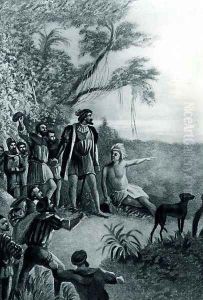Philippoteaux, H. E. Paintings
Paul Dominique Philippoteaux, commonly known as H. E. Philippoteaux (Henry Emmanuel), was a French artist known for his large-scale panoramic paintings and his work in the diorama format. Born on January 27, 1815, in Paris, France, Philippoteaux established himself as a painter with a particular interest in historical scenes and grandiose spectacles.
He was the son of the French artist Felix Philippoteaux, who was a well-respected painter in his own right, and this enabled young Philippoteaux to receive a substantial artistic education. He studied under his father and at the École des Beaux-Arts in Paris, where he refined his skills in the academic tradition.
Philippoteaux gained fame for his panoramic paintings, which were a popular form of entertainment in the 19th century. These massive canvases were displayed in circular buildings and were designed to immerse the viewer in a 360-degree view of a historical scene or a landscape, creating the illusion of being present at the event. One of his most famous works is the 'Cyclorama of Gettysburg,' a gigantic circular painting that depicts the Battle of Gettysburg from the American Civil War. Created in the 1880s, it was a collaborative project that involved extensive research, including visiting the battlefield and interviewing veterans.
His panoramas and dioramas were exhibited in France, Belgium, and the United States, where they were met with both critical and public acclaim. These works not only served as entertainment but also played a role in educating the public about historical events. Philippoteaux's attention to detail and his ability to convey drama and emotion through his paintings contributed to his success.
Apart from his large-scale works, Philippoteaux also produced a number of easel paintings, illustrations, and engravings. He was adept at capturing the likenesses of historical figures and scenes from various periods, which made his work valuable to historians and collectors.
Philippoteaux passed away on October 13, 1884, in Paris. His legacy as a painter of panoramas continued to influence the presentation of historical events in visual culture. The 'Cyclorama of Gettysburg' remains a significant cultural artifact and is preserved at the Gettysburg National Military Park in Pennsylvania, USA.
